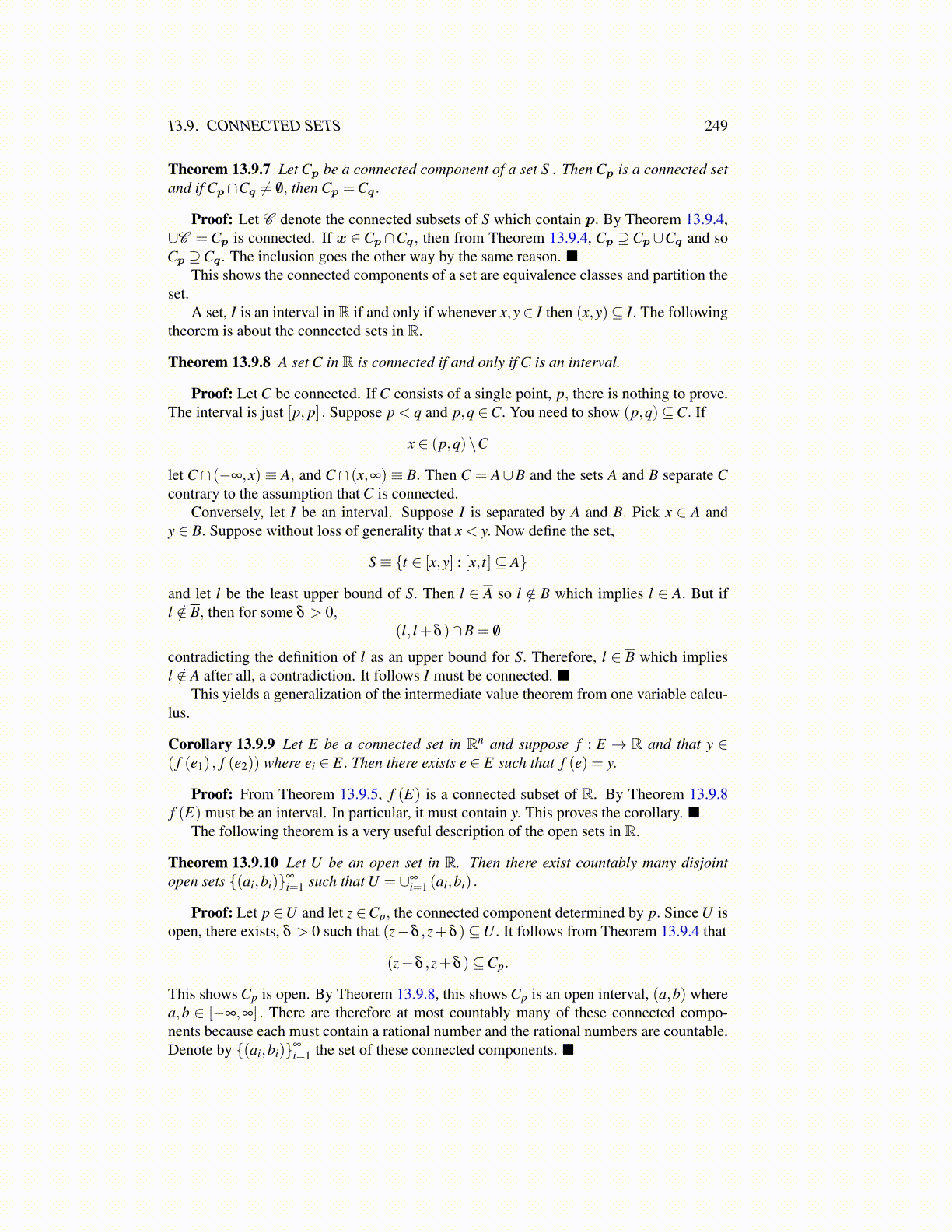
13.9. CONNECTED SETS 249
Theorem 13.9.7 Let Cp be a connected component of a set S . Then Cp is a connected setand if Cp∩Cq ̸= /0, then Cp =Cq.
Proof: Let C denote the connected subsets of S which contain p. By Theorem 13.9.4,∪C = Cp is connected. If x ∈Cp ∩Cq, then from Theorem 13.9.4, Cp ⊇Cp ∪Cq and soCp ⊇Cq . The inclusion goes the other way by the same reason. ■
This shows the connected components of a set are equivalence classes and partition theset.
A set, I is an interval in R if and only if whenever x,y ∈ I then (x,y)⊆ I. The followingtheorem is about the connected sets in R.
Theorem 13.9.8 A set C in R is connected if and only if C is an interval.
Proof: Let C be connected. If C consists of a single point, p, there is nothing to prove.The interval is just [p, p] . Suppose p < q and p,q ∈C. You need to show (p,q)⊆C. If
x ∈ (p,q)\C
let C∩ (−∞,x) ≡ A, and C∩ (x,∞) ≡ B. Then C = A∪B and the sets A and B separate Ccontrary to the assumption that C is connected.
Conversely, let I be an interval. Suppose I is separated by A and B. Pick x ∈ A andy ∈ B. Suppose without loss of generality that x < y. Now define the set,
S≡ {t ∈ [x,y] : [x, t]⊆ A}
and let l be the least upper bound of S. Then l ∈ A so l /∈ B which implies l ∈ A. But ifl /∈ B, then for some δ > 0,
(l, l +δ )∩B = /0
contradicting the definition of l as an upper bound for S. Therefore, l ∈ B which impliesl /∈ A after all, a contradiction. It follows I must be connected. ■
This yields a generalization of the intermediate value theorem from one variable calcu-lus.
Corollary 13.9.9 Let E be a connected set in Rn and suppose f : E → R and that y ∈( f (e1) , f (e2)) where ei ∈ E. Then there exists e ∈ E such that f (e) = y.
Proof: From Theorem 13.9.5, f (E) is a connected subset of R. By Theorem 13.9.8f (E) must be an interval. In particular, it must contain y. This proves the corollary. ■
The following theorem is a very useful description of the open sets in R.
Theorem 13.9.10 Let U be an open set in R. Then there exist countably many disjointopen sets {(ai,bi)}∞
i=1 such that U = ∪∞i=1 (ai,bi) .
Proof: Let p ∈U and let z ∈Cp, the connected component determined by p. Since U isopen, there exists, δ > 0 such that (z−δ ,z+δ )⊆U. It follows from Theorem 13.9.4 that
(z−δ ,z+δ )⊆Cp.
This shows Cp is open. By Theorem 13.9.8, this shows Cp is an open interval, (a,b) wherea,b ∈ [−∞,∞] . There are therefore at most countably many of these connected compo-nents because each must contain a rational number and the rational numbers are countable.Denote by {(ai,bi)}∞
i=1 the set of these connected components. ■